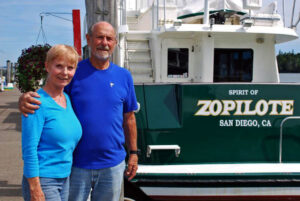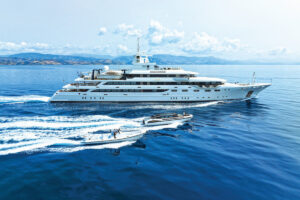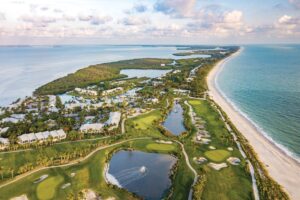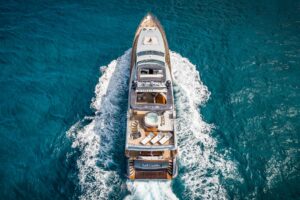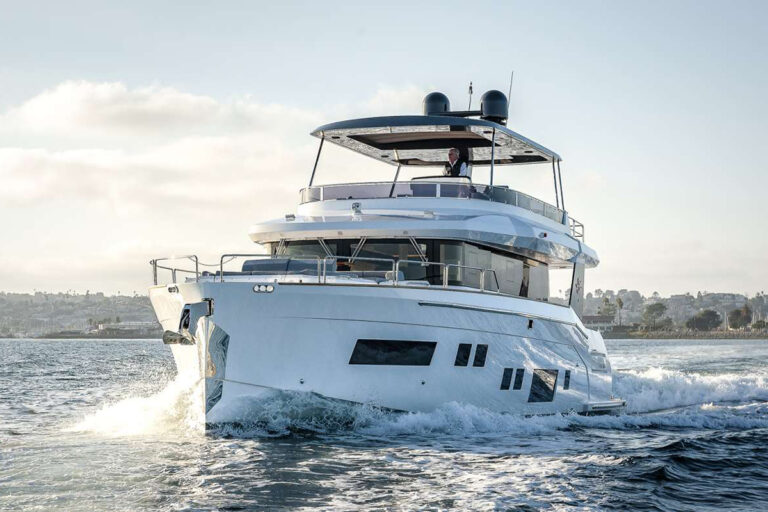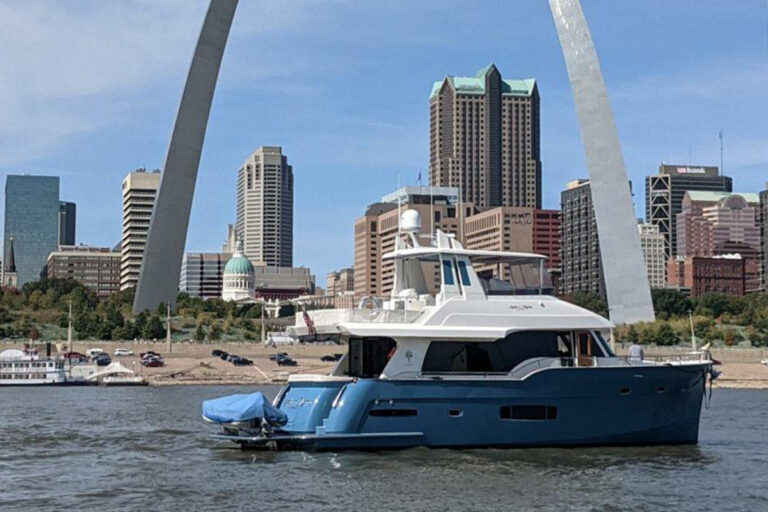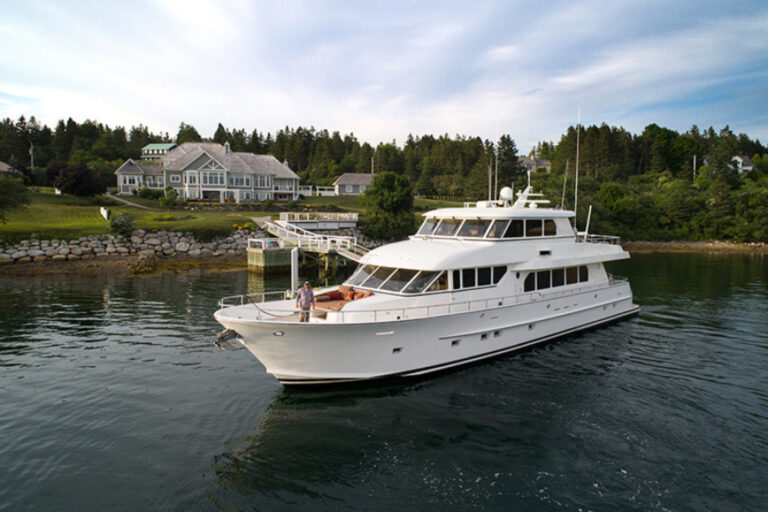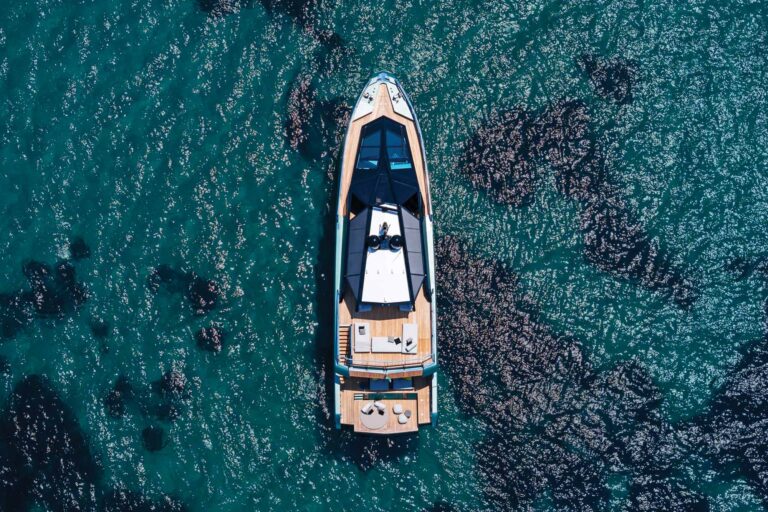On the upper reaches of the River Danube there is a monastery where a cross on the ground marks what is considered to be the center of Europe. Only a few miles to the east of this cross there is a shipyard once known for building luxury yachts despite being 1,000 miles from the nearest sea. Not so surprising, in this unlikely location you have an unusual choice of routes to the sea. If you head east, it is 1,500 miles down the Danube to the Black Sea. To the north and west it is 1,000 miles to the North Sea. For me, whose ambition of a lifetime is to cross Europe by water, the setup was irresistible. Thus a cruise was born, a journey with an unusual twist or two.
To understand the first twist you should look at your boat’s GPS display. If you do, carefully, you may eventually wonder, as I did, why it gives you the height above sea level. This data is unnecessary on the open ocean, since there you will have a pretty good idea of your height. However, on a voyage across Europe in a large motoryacht, height suddenly begins to matter-because there are mountains in the way. And that’s how it happened that on planning my pioneering voyage from the Danube to the Main Canal to the Rhine, I began to wonder if we weren’t going to set a record for the highest you can go in a yacht anywhere in the world-to be exact, elevation 1,200 feet.
When I joined Natalie to make her maiden voyage to the sea, I found myself in darkest Mitteleuropa, land of Rhine Maidens and Valkyries and battlegrounds soaked in the blood of invaders and Crusaders. At this time, only four years ago, the once glamorous sections of the River Danube were no place for luxury yachts; the Kosovo war had destroyed bridges and infrastructure, rendering the river’s upper reaches unfit for navigation. PR Marine was located on those upper reaches, although in Germany, and Natalie was its largest yacht up to that time (the company has since gone out of business, transferring many of its designs to other yacht builders, including Millennium). The 82-foot yacht was molded in fiberglass to a design by Paolo Scanu, combining Italian style with German-built quality. Her moderate-V-hull and skeg improved the directional stability, particularly at slow speeds-which turned out to be good for the river and canal trip. The power units were twin MAN 1,100 hp diesels coupled to a propeller and shaft system, with the propellers recessed into semi-tunnels. Top speed was 28 knots and cruising 24. A bowthruster provided low-speed maneuverability.
Our route to the sea first climbed up through the new Rhine-Main-Danube Canal to the watershed that divides the two main rivers of Europe, and then dropped the 1,200 feet down the Rivers Main and Rhine to the North Sea, where Natalie would get her first taste of salt water. She would be the largest yacht to transit the new canal and make this epic journey across Europe.
From the boatyard at Kelheim to the start of the canal was just a mile. The new canal represented the fulfillment of a dream to link the main rivers of Europe. Some 120 years ago King Ludwig I of Germany had pioneered a small-scale canal linking the Danube and Rhine; the new canal is the culmination of a 20-year construction program designed to allow 1,000-ton barges to transit across Europe.
Natalie was dwarfed by the scale of the locks, where day seems to turn to night between the 70-foot-high dripping walls. As the lock fills, the yacht rises to a new vista of the rolling, rural countryside. Here much of the history of Europe has been created, the steep-sided valleys providing the route for invading armies from both directions. Old towns and castles testify to the historic quarrels, which have taken place in the region over the centuries.
The first night was spent near Roth, on the “downhill side and still a long way above sea level. The canal is designed primarily for commercial traffic, so we kept company with a barge heading north, sharing the locks to conserve water. These locks are unique: The top gate rises out of the water to seal the gap while the mighty bottom gates drop like a guillotine to hold the water back. It all operates with German efficiency, with each lock passage taking around 10 minutes.
Nuremberg is the major town on the canal, but the scenery is mainly rural, with the countryside reflecting the prosperity typical of Bavaria. Natalie attracted a lot of attention, as nothing of her size in a yacht had passed this way before. Speeds on the canal are kept down to 6 knots, and we found joggers and cyclists passing us on the towpath.
By the afternoon of the second day we passed through the final lock on the canal at Bamberg, and into the River Main. This was a tough test, with over 50 locks to transit to reach the mighty Rhine. This was not only a strain of our patience and driving skills, but commercial traffic always had priority because they pay to use the locks and we don’t.
The river meanders through the hills of Bavaria, where there are vineyards on the south-facing slopes. The locks come up every 10 miles or so. On this Sunday the church bells tolled across the countryside from the villages of ancient gates and watchtowers.
We spent Sunday night in the small commercial harbor at Ochsenfurt, where the cobbled streets and restaurants provided welcome relief. We celebrated our progress with the traditional bottle of brandy, with the neck of the bottle thrown overboard to placate the water gods.
Perhaps our celebration was a little premature, because much commercial traffic clogged the river. After passing Würzburg and its dominating castle, the river returns to its meandering course and its rural aspect. Herons hunted for fish, and hawks patrolled the forests. Among the many reminders of the region’s history were the red stone bridge at Lohr and the hilltop monastery at Marktheidenfeld. While waiting at one lock, the skipper’s wife on a barge ahead jumped overboard with a scrubbing brush to clean the hull. It was a definite Rhine Maiden-or, technically, Main Maiden-sighting.
The next day there was a swirling fog on the early morning start. It added an air of magic and mystery to the river, as well as real danger, as the huge barges loomed out of the fog, seemingly filling the whole river. With our arch mast down to give us bridge clearance, the radar was out of action. Later, we felt our way into the first lock, just squeezing in behind three barges. Although the locks on the river were now 1,000 feet long and speeded our progress, the traffic increased as we neared the Rhine. We moved down the river in procession, always behind one or more barges, and into the cityscape of Frankfurt. Our excitement mounted as we entered Kostheim lock, the last lock between us and the sea. Now we were merely 300 feet above sea level-although the sea itself was still 400 miles away.
After days in relatively narrow canals and rivers, nothing prepared us for the scale of the Rhine. At Mainz, where we left the River Main, the Rhine was already a majestic river, busy with traffic and with a powerful current. In this relatively uncontrolled river we had to keep to the buoyed channels, in places quite narrow and often wandering across the river. Mainz is a dreary industrial town, but at Eltville across the river the bank is lined with exclusive villas. Many of them, like Schloss Wiesbaden, are magnificent. We were now in the famous Rhine wine country. Extensive vineyards lined the hills.
Several miles farther on, the pace of the river quickened. Ahead, the hills closed in and we entered the famous Rhine gorges. The entrance is marked by the magnificent Niederwald statue on the hillside opposite the town of Bingen, built to mark the reestablishment of the German Empire in 1883. The channel buoys were nearly awash in the 5-knot current and rapids formed in the river. The Tower of Mauseturm in the center of the river marks the entry to the gorges proper and here the traffic increased, thanks to the large number of tourist boats. The crags above the river support castles, some built to defend this major trade route, others built in quieter times as mansions with probably the best views in Germany. Restaurants and hotels, many of an extravagant baroque style of architecture, line the banks.
Rushing downstream, sometimes at close to 20 knots, we found ourselves contending with a very busy traffic flow in the twisting channel. Traffic going upstream has priority and switched from side to side as it tried to dodge the strong current. Just to add to the confusion were the barges under tow, many with a long distance between tug and barge. It could be a fatal mistake to try to pass between them.
Right in the middle of the river at Kaub is the dramatic old customs house erected to collect tolls from passing river traffic. Then comes the Lorelei rock, where a beautiful maiden is reputed to have posed on the towering cliff edge to lure sailors to their doom. Without engine power, this must have been an extremely dangerous section of the river in the past, and even without the distraction of a beautiful maiden, many lives must have been lost in the swirling currents. Today there is a traffic control system on the very sharp bends in the river, mainly for use when the river is low and the current very strong.
Coming downstream, we passed in rapid succession towns, villages, castles and monasteries. Almost every hillside has its castle, but, alas, there were no stopping places for a yacht of our size. It was a pity not to get ashore and explore. The countryside finally flattened and the pace slowed on the approach to the spired city of Koblenz.
Koblenz was also the first bridge over the wide river since Mainz, and our first glimpse of the modern high-rises in awhile. Here, the beautiful River Moselle ends its tortuous passage through the hills and reinforces the flow of the Rhine. The large statue at the confluence, the Deutsches Eck, is a reminder of the 12th century knights who settled here. On the opposite bank is the spectacular fortress of Ehrenbreitstein.
Bonn, the old capital of West Germany, appeared next on the left, presenting an uninspiring face. Cologne-built because of the river, with its ancient twin-spired cathedral dominating the waterfront scene-made up for the disappointment of Bonn. Here I left Natalie to continue her journey downriver past Düsseldorf and industrial Duisburg, and into the flat countryside of Holland.
I was satisfied to have pioneered a route across Europe for motoryachts. It’s long and winding and requires courage to mix with the heavy commercial traffic, but the stunning scenery makes it worth the effort.

